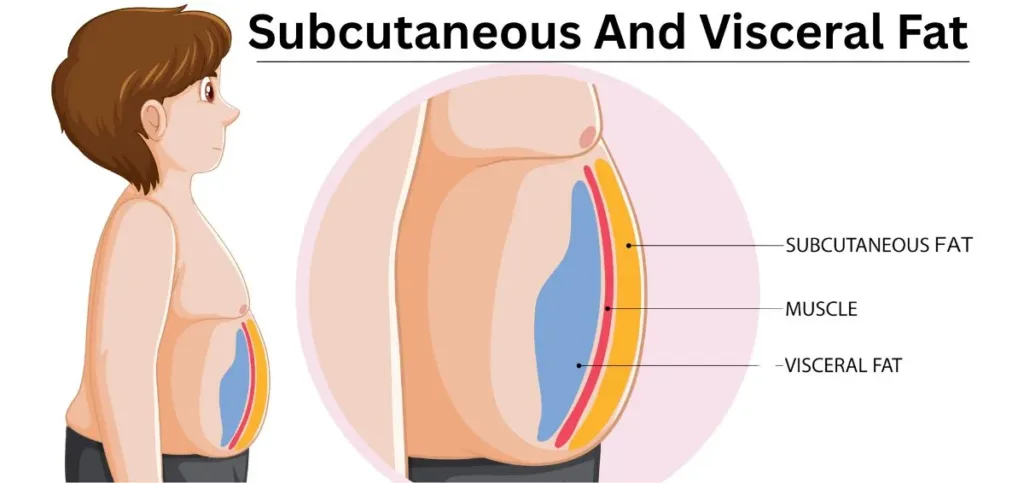
Belly fat is one of the most stubborn and annoying health issues for individuals of all ages. It is more than just about looks; it’s a multifactorial combination that includes lifestyle choices, hormones, genetics, stress, diet, and metabolism. It is a strong reflection of one’s metabolic health, hormonal health, or the lifestyle patterns associated with both.
Whether you are looking to read the ultimate guide to belly fat, this guide is simply explained, in a structured way, for real-life solutions and self-management. Let’s get started.
What is Belly Fat and Why Does It Matter?
Belly fat is simply fat accumulation in the abdomen. Are the causes of abdominal fat different from those of fat in the hips, arms, or legs? The excess fat around the waistline is unique because it becomes metabolically active, releasing hormones and chemicals that can affect your entire health system.
Many consider belly fat to be simply a cosmetic or body shape issue, but recent medical research has shown us that it is much more dangerous than fat found in the outer layers of your body. Belly fat is strongly associated with chronic inflammation and metabolic disease.
The midsection fat matters not only because of appearance but also for how it affects metabolism, hormones, and long-term health. Excess abdominal fat is linked to:
- Cardiovascular disease
- Insulin resistance
- Type 2 diabetes
- High blood pressure
- Inflammation
- Hormonal imbalance
Understanding the types of abdominal fat and the key belly fat helps you take the right steps to reduce it safely and naturally.
Types of Belly Fat, How It Affects?
There are two key types of belly fat, and understanding how each behaves can help you target it more effectively.

Subcutaneous Fat (Under the Skin)
Subcutaneous fat is the soft fat that is directly below your skin. It’s what you can pinch in your stomach, thighs, and hips.
Here are some common characteristics of subcutaneous fat:
- It serves as a store of energy in the body.
- It provides insulation and cushioning.
- Subcutaneous fat carries less risk than visceral fat.
- As this fat is stored as a source of energy, it is difficult to lose.
It can cause some cosmetic concerns, but experts argue that subcutaneous fat is not as dangerous as the fat layers deeper within the body.
Visceral Fat (Around the Organs)
Visceral fat encircles crucial organs such as the liver, pancreas, and intestines. It is much more pathological and highly correlated with chronic health conditions.
Reasons why visceral fat is dangerous :
- Secretes an inflammatory hormone
- Raises the risk of metabolic syndrome
- Elevates LDL (“bad”) cholesterol
- Harms liver function
- Affects insulin sensitivity
- Visceral fat commonly builds up due to stress, diet, hormonal changes, and inactivity.
Which is More Dangerous?
Without doubt, visceral fat is significantly more dangerous than subcutaneous fat.
According to your references and global research:
- Visceral fat raises long-term health concerns.
- It contributes to body inflammation.
- It accelerates aging and induces metabolic dysfunction.
This means that downsizing your belly fat is not just a cosmetic option, but an important one for enhanced health.
What Are the Main Causes of Belly Fat?
The causes of belly fat differ from person to person. Some of the most common reasons include:
1. Poor Diet
The consumption of large quantities of refined carbohydrates, sugary beverages, fast foods, and processed snacks is a major factor in the development of abdominal body fat.
So-called foods that are related to belly fat are:
- White bread, pastries, and pasta
- Fried and oily foods
- High-sugar beverages
- Excess alcohol
- Packaged snacks and sweets
2. Sedentary Lifestyle
Calorie-burning activity is reduced when physical movement is cut down, and this means less muscle mass is made and more fat is stored, especially in the belly area.
Long hours of sitting are now termed “the new smoking” due to their harmful impact on metabolism.
3. Stress and Cortisol Imbalances
One of the first things that happens when we are stressed is the production of the hormone cortisol, which in turn signals the body to put away fat, especially visceral fat.
4. Hormonal Changes
Hormonal factors are significant in fat distribution.
The causes of belly fat in women include: menopause, decline in estrogen, thyroid disorders, and PCOS.
The causes of belly fat in men are low testosterone, aging, and unhealthy living.
5. Genetics
Some individuals have a fat distribution around the waist area as their genetic feature, which causes them to store more fat there. Still, lifestyle can overpower genetic predisposition even though genes cannot be altered.
6. Poor Sleep Quality
Lack of sleep alters the action of hunger hormones like ghrelin and leptin, thus increasing the number of calories consumed and promoting fat storage.
7. Alcohol Consumption

Alcohol is devoid of nutrients (or empty calories), and at the same time, it slows down fat burning; excess fat tends to be deposited in the abdominal region.
8. Aging
The natural process of ageing slows metabolism and shifts hormonal balance, making it easier for one to gain fat, particularly around the waistline.
Recognizing what causes abdominal fat makes it easier to create the right nutrition, exercise, and lifestyle plan to reverse it.
Health Risks of Belly Fat
According to global health institutions and your provided references, excess fat around the waistline is linked with:
1. Cardiovascular Disease
Visceral fat triggers inflammation and raises harmful cholesterol, increasing artery blockage and putting extra strain on the heart, which significantly raises the risk of heart attacks and long-term cardiovascular problems.
2. Type 2 Diabetes
Excess belly fat reduces insulin sensitivity, leading to elevated blood sugar levels. Over time, this hormonal disruption increases the likelihood of developing type 2 diabetes and other metabolic disorders.
3. Hypertension (High Blood Pressure)
When abdominal fat compresses internal organs and blood vessels, it increases resistance and pressure, making the heart work harder and leading to consistently high blood pressure levels.
4. Fatty Liver Disease
Visceral fat around the abdomen sends fatty acids to the liver, which can lead to fat buildup, fatty liver disease, and impaired liver function.
5. Hormonal Imbalances
Belly fat produces hormones and inflammatory chemicals that disrupt the endocrine system, leading to irregular menstrual cycles, mood swings, low energy, and difficulty managing weight, especially in women.
6. Chronic Inflammation
Visceral fat continuously releases inflammatory markers that affect multiple organs, weaken immunity, and contribute to conditions such as arthritis, digestive issues, and overall accelerated ageing.
7. Increased Mortality Risk
Research shows that even normal-weight individuals with excess belly fat face a higher mortality risk, making abdominal fat one of the most important indicators of long-term health.
This highlights why understanding the health risks of belly fat is crucial for long-term wellness.
Want to Lose Belly Fat Naturally?
The good part is? By gradually changing your lifestyle, you can naturally lose belly fat. The most powerful, long-term fat reduction methods based on research are outlined below.
Adhere to These Tried and True Diet Suggestions
80% of abdominal fat is due to nutrition. The best diets to reduce belly fat are:
1. High-Fibre Foods are the Best
Fibre keeps you satiated and, at the same time, reduces calorie intake.
The best sources are:
- Oats
- Chia Seeds
- Quinoa
- Fruits and Vegetables
2. Raise Protein Intake
Protein speeds up metabolism and reduces hunger.
Incorporate:
- Eggs
- Lentils
- Chicken breast
- Greek yogurt
3. Cut Down on Refined Carbohydrates and Sugars
Stay away from:
- Sugar-laden beverages
- White bread
- Candies
- Packaged foods
4. Go for Healthy Fats
Good fats help stabilize hormones, and less inflammation occurs.
Consume:
- Avocado
- Nuts and Seeds
- Olive Oil
5. Keep Drinking Water
Water hydrates, plus it helps to tidy up your body and make you feel less bloated.
6. Have a Balanced Meal Plan
A well-structured diet to lose belly fat fast should include:
- Lean proteins
- Whole grains
- Plenty of vegetables
- Minimal sugar
- Adequate hydration
- Begin Exercising Daily
Effective Exercises for Belly Fat Reduction
Here are the most effective exercises for belly fat as well as overall fat loss:
1. Cardio / Aerobic Exercises

These are the most effective ones if you want to lose overall weight:
- Brisk walking
- Jogging
- Cycling
- Swimming
2. High-Intensity Interval Training (HIIT)
These are short, vigorous drills that eliminate fat aggressively.
Some of them are:
- Jumping jacks
- Burpees
- Sprint intervals
3. Strength Training
It builds muscles, thereby increasing the metabolic rate.
Do the following:
- Squats
- Lunges
- Deadlifts
- Planks
4. Core-Focused Exercises
These are the exercises targeting belly fat that also help build the core:
- Plank variations
- Leg raises
- Russian twists
- Mountain climbers
Remember: spot reduction is a myth, but core workouts do increase strength.
Try Natural Remedies
If you want extra support in your routine, simple natural remedies for belly fat can help. Warm lemon water boosts digestion and metabolism, while green tea provides antioxidants that support fat burning. Ginger water helps ease inflammation and reduce bloating, and apple cider vinegar can stabilize blood sugar for better weight control.
Cumin water is a traditional remedy known to ease abdominal bloating and support digestion. These easy, safe home remedies work best when paired with a balanced diet and regular exercise.
Common Myths About Belly Fat: Stop Believing
A lot of individuals tend to believe in the prevalent belly fat myths, but knowing the reality can spare you the trouble of wasting your time and getting frustrated. Crunches can’t remove belly fat because spot reduction doesn’t work, and skipping meals only slows your metabolism and disrupts hormones.
Belly fat is more than a mere trivial issue; it is associated with significant health risks that, in turn, affect the long-term wellness of individuals. Fat-burning pills claim to deliver fast results but turn out to be both ineffective and unsafe. Also, it is a misconception that consuming healthy fats contributes to weight gain; in fact, it promotes proper metabolism and reduces belly fat. Awareness of such myths prevents you from falling for tricks and shifts your focus to scientifically proven effective methods that truly make a difference.
How to Maintain a Flat Belly Long-Term
A flat stomach is not a quick result; it is a product of continuous good lifestyle choices.
1. Balanced Diet is the Key
The very first step to a flat belly is the continuous eating of unprocessed food like fruits, vegetables, lean proteins, and whole grains while restricting the intake of sugar and junk snacks. It not only causes cravings but also affects hormone storage and abdominal fat.
2. Be Active
Movement every day keeps the metabolism lively and the fat away. Walking, yoga, cycling, and strength training for at least 30 minutes a day help keep the energy, strength, and long-term control over belly fat.
3. Stress Management
Long-term stress elevates cortisol levels, a hormone that promotes the accumulation of fat around the belly. Simple activities like controlled breathing, meditation, yoga, or quiet walking help to relax the brain, regulate the hormones, and, naturally, the body has a flat stomach.
4. Sleep 7-8 Hours
Good-quality sleep helps control appetite and regulate hormones. It prevents late-night craving and slow metabolism. Seven to eight hours of sleep each night will enable the body to burn fat effectively.
5. Drinking Water
Proper water intake helps digestion, reduces bloating, and helps manage hunger since thirst can make a person think they are not hungry. Drinking the recommended amount of water a day increases metabolism, gets rid of toxins, and makes the stomach feel light, comfortable, and less contaminated over time.
6. Monitor Portion Size
Overeating of even the healthiest of foods can lead to weight gain; hence, portion control must be practiced. Eating slowly, picking up smaller plates, and listening to real hunger signals are ways that prevent overeating and assist in the long-term maintenance of belly fat.
7. Avoid Crash Diets
Crash diets might lead to drastic weight loss in a very short period of time, but they also slow down the metabolism, increase cravings, and lead to rapid regain.
Conclusion
Belly fat isn’t just excess weight around your waist; it’s a complex health issue influenced by diet, hormones, lifestyle, and genetics. The ultimate guide to belly fat indicates that with the right balance of diet, exercise, natural remedies, and long-term lifestyle changes, you can achieve safe and effective belly fat loss.
The aim is not only to reduce belly fat quickly but to create habits that lead to overall health and wellness. Start today, be consistent, and your body will thank you.
FAQs
What is the best way to lose belly fat?
There is no fixed solution to lose belly fat. But with the right combination of diet, exercise, stress management, and good sleep, one can lose belly fat.
Why is it difficult to lose belly fat after 40?
As ageing slows metabolism, hormonal changes lead to the accumulation of fat in the abdominal area, making it difficult to lose belly fat after age 40.
Which part of the body loses fat fast?
The neck and the face are sensitive areas responding positively to the loss of weight in a shorter time span.
How does too much visceral fat impact health?
When there is excessive visceral fat, different types of health issues may arise, such as high blood pressure, insulin resistance, and higher incidences of heart disease. On the other hand, subcutaneous fat can be targeted through diet or exercise and is easier to remove than visceral fat. Losing visceral fat may require a more habitual approach.
Can the belly affect mental health?
Yes, excess visceral fat is associated with higher levels of cortisol and inflammation, which increase risk for developing anxiety, depression, or elevated levels of stress.










